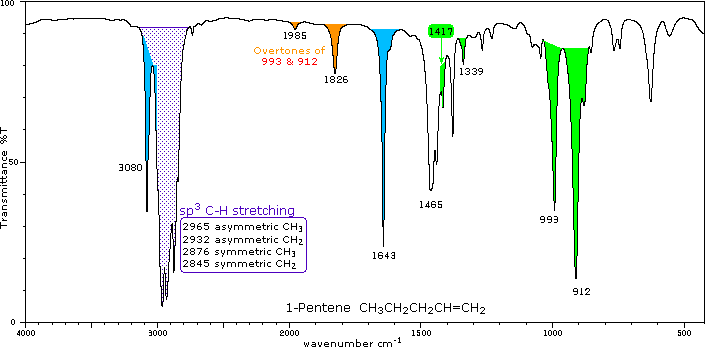
Note the O= CH stretches in both aldehydes in the region 2830-2695 cm -1, especially the shoulder peak at 2725 cm -1 in butyraldehyde and 2745 cm -1 in benzaldehyde.

Note that the O=C stretch of the alpha, beta-unsaturated compound - benzaldehyde - is at a lower wavenumber than that of the saturated butyraldehyde. The spectra of benzaldehyde and butyraldehyde are shown below. Not specified, most likely a prism, grating, or hybrid spectrometer. alpha, beta-unsaturated aldehydes 1710-1685 cm -1.If you suspect a compound to be an aldehyde, always look for a peak around 2720 cm -1 it often appears as a shoulder-type peak just to the right of the alkyl CH stretches. Since the band near 2830 cm -1 is usually indistinguishable from other CH stretching vibration bands (recall that the CH stretches of alkanes appear from 3000-2850 cm -1), the presence of a moderate band near 2720 cm -1 is more likely to be helpful in determining whether or not a compound is an aldehyde. This band generally appears as one or two bands of moderate intensity in the region 2830-2695 cm -1. See also:Īnother useful diagnostic band for aldehydes is the O= CH stretch. As in ketones, if the carbons adjacent to the aldehyde group are unsaturated, this vibration is shifted to lower wavenumbers, 1710-1685 cm -1. For one thing, all of these functional groups appear to the right of the C-H absorptions, which always occur between 2,800 cm 1 to 3,000 cm 1 in the IR spectrum, and.

The carbonyl stretch C=O of saturated aliphatic aldehydes appears from 1740-1720 cm -1. You can locate carbonyl groups, alkenes, alkynes, and aromatics in the IR (infrared) spectrum, based on their shapes and relative locations. IR: aldehydes IR Spectroscopy Tutorial: Aldehydes


 0 kommentar(er)
0 kommentar(er)
